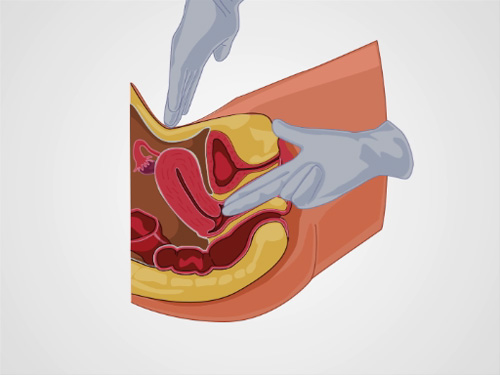盆腔检查三: 双手和直肠阴道考试
Overview
资料来源:
亚历山德拉 · 邓肯,GTA,实践临床,纽黑文康涅狄格
蒂凡尼库克,GTA,实践临床,纽黑文康涅狄格
Jaideep S.Talwalkar,MD、 内科、 儿科,耶鲁大学医学院,纽黑文,康涅狄格
双手的考试是一个全面的检查病人的子宫颈、 子宫和卵巢。它可以告诉经验丰富的供应商很多,因为它可能导致的异常,如囊肿、 子宫肌瘤或恶性肿瘤发现。然而,它是解剖的有用甚至在没有这样的结果,因为它允许,医生就能建立一个理解病人供将来参考。
执行双合诊考试窥镜考试可以帮助精神放松患者之前, 和身体上之前什么往往被视为"最创"考试的一部分。医生已经熟悉病人的解剖结构可以插入阴道镜更顺利和舒适。然而,在双合诊考试过程中使用的润滑可能会干扰处理某些窥镜考试期间获得的样本。供应商必须熟悉当地实验室加工要求在提交具体的考试顺序之前。
这个示范以窥器考试; 结束后立即开始因此,它假定病人提供了历史,在改良截石位。
直肠阴道考试并不总是必要的但它可能进行全面评估后倾子宫和卵巢 (这可能是唯一能完成全面评估取决于子宫的位置),或者评估直肠。
Procedure
1.双合诊考试

图 1。双合诊考试。正确定位为双合诊考试考官的手。
- 准备病人说,"我将现在将两个手套的手指放在你的阴道,用另一只手按住你的腹部来评估你的子宫和卵巢。
- 充分大衣你惯用手与润滑剂的前两个手指。
- 坐,告诉病人将一个,然后两个手指放在病人的阴道。
- 占主导地位的食指插入,用其他手指塞进阴道口 1 英寸手心向下。后按压来打开块和插入中指。
- 应用后的压力,以免拽阴唇和把手。
- 插入手指完全病人的阴道,同时向一侧,另一方面你第四和第五的手指移动去用你的拇指阴唇。
- 释放的阴唇、 休息你外部的手指在腹股沟斜槽,和站起来。
- 将你惯用的脚放在脚凳上,塞进你的身边,你占主导地位的胳膊肘和软化你的手腕。如果需要更大的压力来插入手指更远,站直并使用你的核心没有病人持续
Application and Summary
Tags
跳至...
此集合中的视频:

Now Playing
盆腔检查三: 双手和直肠阴道考试
Physical Examinations II
147.7K Views

眼科检查
Physical Examinations II
77.2K Views

眼底检查
Physical Examinations II
68.0K Views

耳朵考试
Physical Examinations II
55.1K Views

鼻子、 鼻窦、 口腔和咽部考试
Physical Examinations II
65.8K Views

甲状腺考试
Physical Examinations II
105.0K Views

淋巴结考试
Physical Examinations II
387.4K Views

腹部考试 i: 检查和听诊
Physical Examinations II
202.6K Views

腹部考试 II: 打击乐
Physical Examinations II
248.2K Views

腹部考试 III: 触诊
Physical Examinations II
138.5K Views

腹部考试四: 急性腹痛评估
Physical Examinations II
67.3K Views

男性直肠检查
Physical Examinations II
114.5K Views

全面的乳房检查
Physical Examinations II
87.6K Views

外生殖器的盆腔检查 i: 评估
Physical Examinations II
307.1K Views

骨盆 II: 窥镜考试成绩
Physical Examinations II
150.4K Views
版权所属 © 2025 MyJoVE 公司版权所有,本公司不涉及任何医疗业务和医疗服务。
